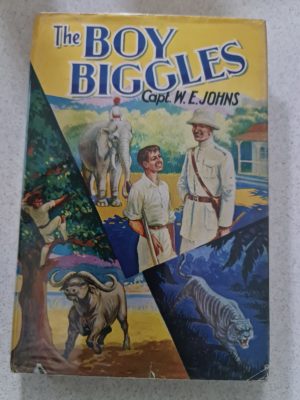Capt. W. E. Johns – Biggles of the Camel Squadron
This edition of Biggles of the Camel Squadron, was published by the Thames Publishing Company and has no dustcover. Thames have the most annoying habit of printing the publication date of the book on the rear side of the pastedown of the inner front cover. This means you can’t easily see it. The inside pastedown cover can be lifted by soaking it in water, which destroys your book. Alternatively, it can be viewed by using alcohol Isopropanol (99.9 % pure alcohol, please read http://www.biggles.info/Details/47/Dating/ if you wish to use alcohol to view the publishing date).
According to http://www.biggles-online.com/book/biggles-of-the-camel-squadron/editions/ This Thames edition of Biggles of the Camel Squadron was published between 1954 and 1959.
This edition is in very good condition. The spine is virtually, as new. The front and back covers are as new, which is excellent, for a book over 50 years old. The inside cover is in good condition, as is the page opposite. The next page, the gutter between the loose free the title page is coming apart at the 20mm. The gutter joining the next few pages is also fragile and care should be taken turning the pages for the first few pages. The back inside cover and all pages are in excellent condition. The hinge is in excellent condition, as is the gutter, except, as previously mentioned, for the first few pages. The book itself inside, is in very good condition. Further photographs can be provided, if requested.
$76.00
+ Free ShippingDescription
This edition of Biggles of the Camel Squadron, was published by the Thames Publishing Company and is a hardcover, has no dustcover but the photo is laminated into the hardcover front and back covers. Thames have the most annoying habit of printing the publication date of the book on the rear side of the pastedown of the inner front cover. This means you can’t easily see it. The inside pastedown cover can be lifted by soaking it in water, which destroys your book. Alternatively, it can be viewed by using alcohol Isopropanol (99.9 % pure alcohol, please read http://www.biggles.info/Details/47/Dating/ if you wish to use alcohol to view the publishing date).
According to http://www.biggles-online.com/book/biggles-of-the-camel-squadron/editions/ This Thames edition of Biggles of the Camel Squadron was published between 1954 and 1959.
This edition is in very good condition. The spine is virtually, as new. The front and back covers have a few stains, but only minor blemishes, on a book over 50 years old. The inside cover is in good condition, as is the page opposite. The back cover is marked, as is the page opposite. The hinge is in excellent condition, as is the gutter. The book itself inside, is in very good condition. Further photographs can be provided, if requested.
Biggles of the Camel Squadron is a collection of short stories set in World War One. Five of the stories (‘The Professor’, ‘The Joy-Ride’, ‘The Bridge Party’, ‘The Bottle Party’ and ‘The Trap’) were originally published in five issues of Popular Flying Magazine, from January 1933 until May 1933 and written by the author who served as an officer in the British air force (the Royal Flying Corps and then the RAF) in the First and Second World Wars.
These stories were later all published in thirteen parts, with individual story titles, in The Modern Boy, issues 284 to 296, dated 15th July 1933 to 7th October 1933
Biggles of the Camel Squadron was first published in book form in March 1934 by John Hamilton. It was only the third ever Biggles book, although by this time, Johns had also published two other books: Mossyface in 1922 and The Spy Flyers (1933). After three John Hamilton editions, Camel Squadron was brought out again in 1938 by the Boys’ Friend Library with the potentially confusing title of Biggles Goes to War, around the same time as when OUP was bringing out the actual Biggles Goes to War!
The Thames and Dean and Son editions of the 1950s – 1980s restored the original title. Red Fox published a new edition of the book in 1992 under the title Biggles of the Fighter Squadron. The motivation behind this change of title is unknown however, it was perhaps to avoid unwary readers thinking it was about a cavalry officer in the Camel Corps?
Please note, all photographs are high-resolution and therefore, magnify all blemishes.
Arrangements can be made to view any of our books and further photos can be supplied upon request.
If you require any further information, please email us at Info@Books4U.Website or select Books4U and send us a message. All constructive feedback is welcomed.
Books4U always loves to hear from you. All feedback is welcomes. Is there a book you wish us to edit and publish as an eBook? Please remember, we are unable to edit and publish books which were first published after 1953, as they are still under copyright.















Reviews
There are no reviews yet.